
FIRST FRAME ROOM
Narrative development for screen projects.
We create editorial pitch materials — one-pagers, visual decks, and story bibles — designed to speak the industry’s language.Alongside this, First Frame Room also curates a highly selective Publishing line, focused on narrative projects conceived to live beyond the written page.
ABOUT US

First Frame Room is a visual editorial studio specializing in pitch decks, one-pagers, and series bibles for screenwriters, directors, authors, and production companies.We work alongside projects for both series and film, shaping the tone, structure, and narrative identity of development materials.Our work also includes professional translation and localization in English and Italian, with a focus on narrative, visual, and strategic clarity.We shape stories, instincts, and texts that need to say less — but better — into materials that breathe, speak, and persuade.We work behind the scenes, where ideas turn into structure.Some of our pitches have reached international studios and independent production companies. Others are still on their way. Maybe yours is one of them.Alongside these activities, First Frame Room also curates a selective Publishing line, focused on narrative projects designed to expand beyond the written page.
Our narrative direction
We don’t work on everything.
We focus on projects with a clear identity, a distinctive tone, and the courage to avoid trends.We’re drawn to stories that build relationships, worlds, and meaning.
We don’t just showcase ideas — we help position them.We are selective, but if there’s alignment, we build with conviction.A good idea can be enough.
But a good idea with structure, vision, and form… can go far.That’s why we’ve chosen to extend our work into a selective Publishing line, dedicated to narrative projects conceived to live beyond the written page and open up to new forms of storytelling.
PUBLISHING
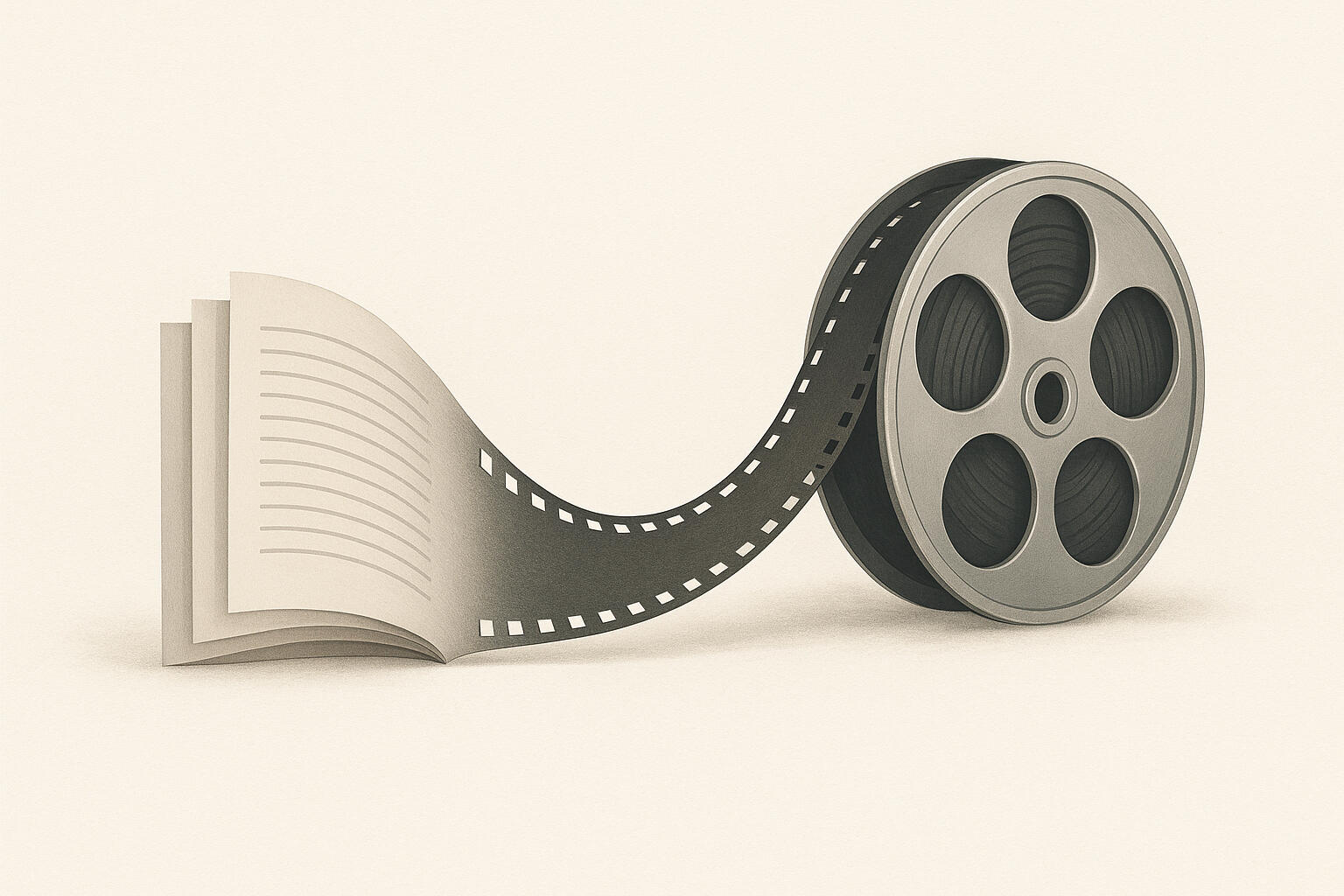
Selective narratives, with wider horizons
𝗗𝗘𝗦𝗧𝗜𝗡𝗜 𝗔𝗟𝗧𝗘𝗥𝗡𝗔𝗧𝗜𝗩𝗜
• 𝗔𝗨𝗧𝗛𝗢𝗥: Nora Levant
• 𝗬𝗘𝗔𝗥: 2025
• 𝗙𝗢𝗥𝗠𝗔𝗧𝗦: Paperback · eBook
• 𝗜𝗦𝗕𝗡: 9798288066535
𝗦𝗬𝗡𝗢𝗣𝗦𝗜𝗦Destini Alternativi is a choral novel born from one of the deepest wounds in Italian history: the bombing at Bologna Central Station on August 2, 1980.
But this is not a story of tragedy. It’s a powerful and moving “what if”—a path not taken. It doesn’t recount the explosion, but imagines what might have happened if fate had shifted just a second earlier.Through the parallel lives of Edoardo, Adelmo, Giulia, Francesco, Sara, and Andrea, the novel explores love, reconciliation, and the choices that—in another version of the world—might have continued to exist.A tribute to those who were denied a future.
A delicate and poignant work that honors memory with the most powerful weapon we have: imagination.
© First Frame Room. For rights or development inquiries: [email protected]
Services

We work with words, structure, and design to create materials that speak the language of the industry—without losing the soul of the project.Whether you’re at the concept stage or already holding a draft, we tailor every document to match your story’s potential and your professional goals.Here’s what we offer:
Narrative One-pager
A clear and compelling one-page document that distills the tone, theme, and potential of your project.Available in Italian and English.
Pitch Deck
Custom-designed pitch presentations that balance visual storytelling and industry expectations.Developed from scratch or based on your materials.
Series Bible – Editing & Layout
We revise and structure your Bible, ensuring narrative clarity, visual coherence, and a smooth reading flow.Each layout is tailored to the project.
Editorial Treatment
A narrative document that gives shape to your idea.
We craft concept, storyline, and development with a clear voice and coherent tone.
Useful in early development or as a foundation for pitch materials.
Lookbook & Moodboard
A visual proposal that enhances and reinforces the project’s tone.
We curate imagery, palettes, and stylistic references to evoke the narrative world and visual feeling.
An effective tool for presenting the project in a striking and immediate way.
Translation & Localization
Narrative-focused translation from Italian to English (and vice versa), with attention to tone, genre, and industry standards.
Strategic Analysis & Positioning
We analyze your project’s tone, format, and potential to help identify the right targets—platforms, agents, or producers—and advise on format and pitch strategy.This is not random pitching. It’s narrative strategy.
Industry Outreach & Submission Strategy
We provide support for the submission of your project to selected platforms, producers, or agents.Based on the tone, format, and potential of your project, we help identify suitable contacts and craft submission materials that align with industry expectations.We don’t promise shortcuts or results—just a sharp, structured approach that gets your work in front of the right people, the right way.
Full Package
A cohesive process that brings together narrative development and visual storytelling: from the one-pager to the pitch deck, from the series bible or film treatment to moodboards and strategic positioning.
For a compelling and market-ready identity.
Publishing
First Frame Room broadens its perspective.
Alongside audiovisual development, an editorial path now opens—dedicated to completed narrative works, selected for their coherence and visual potential.We offer:
– Editorial care
– Graphic design
– Digital distribution
– Dedicated showcaseEach project is evaluated based on its alignment with the studio’s narrative vision.

Collaborations

First Frame Room partners with writers, directors, and producers developing original audiovisual projects.
What we offer
Every project is unique — and so is its presentation:
• Narrative and visual pitch decks for films and series
• Clear, evocative, and targeted one-pagers
• Cohesive and well-structured series bibles with a strong identityEditorial structures shaped around the project’s identity.Every detail has a purpose, every page a voice.
Who we work with
• Writers with a strong concept looking to present it effectively
• Directors in search of a narrative partner
• Independent producers and broadcasters in early co-development stages
They come to us when…
• …an idea is strong but still needs form.
• …a project requires narrative and visual consistency before being pitched.
• …a producer needs materials that speak the industry’s language without losing the author’s voice.
• …a writer seeks guidance, not correction.
• …there’s a deadline looming and clarity is needed fast.
• …someone writes “Pitch due Friday” and what arrives is everything — except clarity.
How it works
We only take on selected projects.
It all starts with a first conversation: vision, available materials, goals.
If there’s alignment, we design a tailored process.
Those who choose us aren’t looking for shortcuts. They’re looking for direction.Got a project to share?
Write to us through the form or at [email protected]
We reply thoughtfully — never in a rush.
Team

First Frame Room is a collective of freelancers:
we work as a network, combining diverse skills with a shared, coordinated approach.
N. - Editorial Lead & Development
Responsible for editing, rewriting, and making structure feel like intuition.
M. – Design & Visual Identity
Handles layout, pitch deck design, typography, and the occasional emotional damage from broken InDesign files.
V. – Strategy & Positioning
Analyzes tone, format, and project potential. Knows which door to knock on, and how to introduce the story.
A. – Translation & Localization
Ensures every word makes sense in two languages, and in both hemispheres.
E. – Project Coordinator
Oversees the rhythm of each project, balancing timing, structure, and creative flow.
Bridges ideas and execution, keeping everything aligned from concept to delivery.
Sometimes we work solo. Sometimes in chorus.
Our team is small, adaptable, and answers with one voice (most of the time).

The Shape of the Story
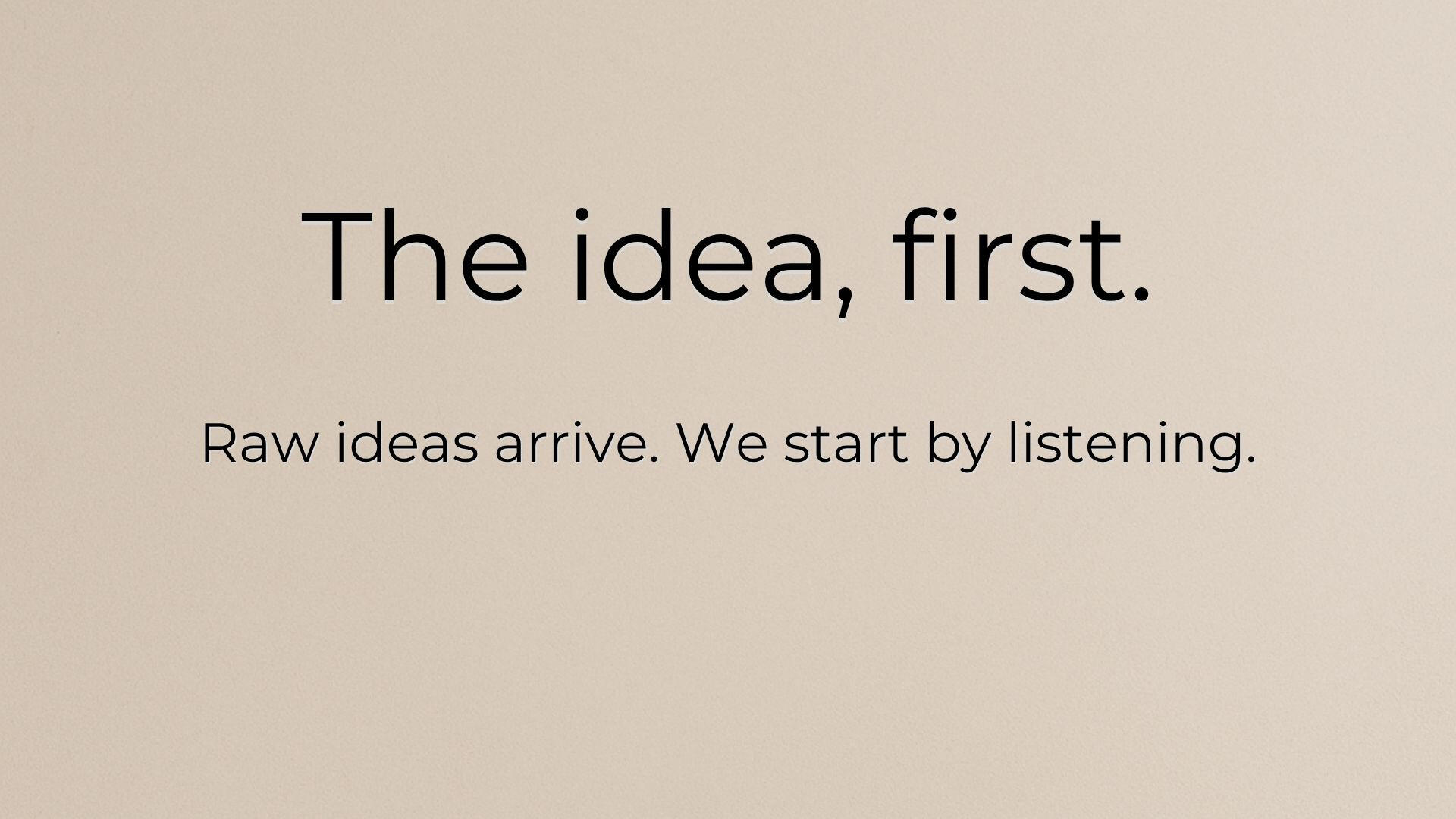
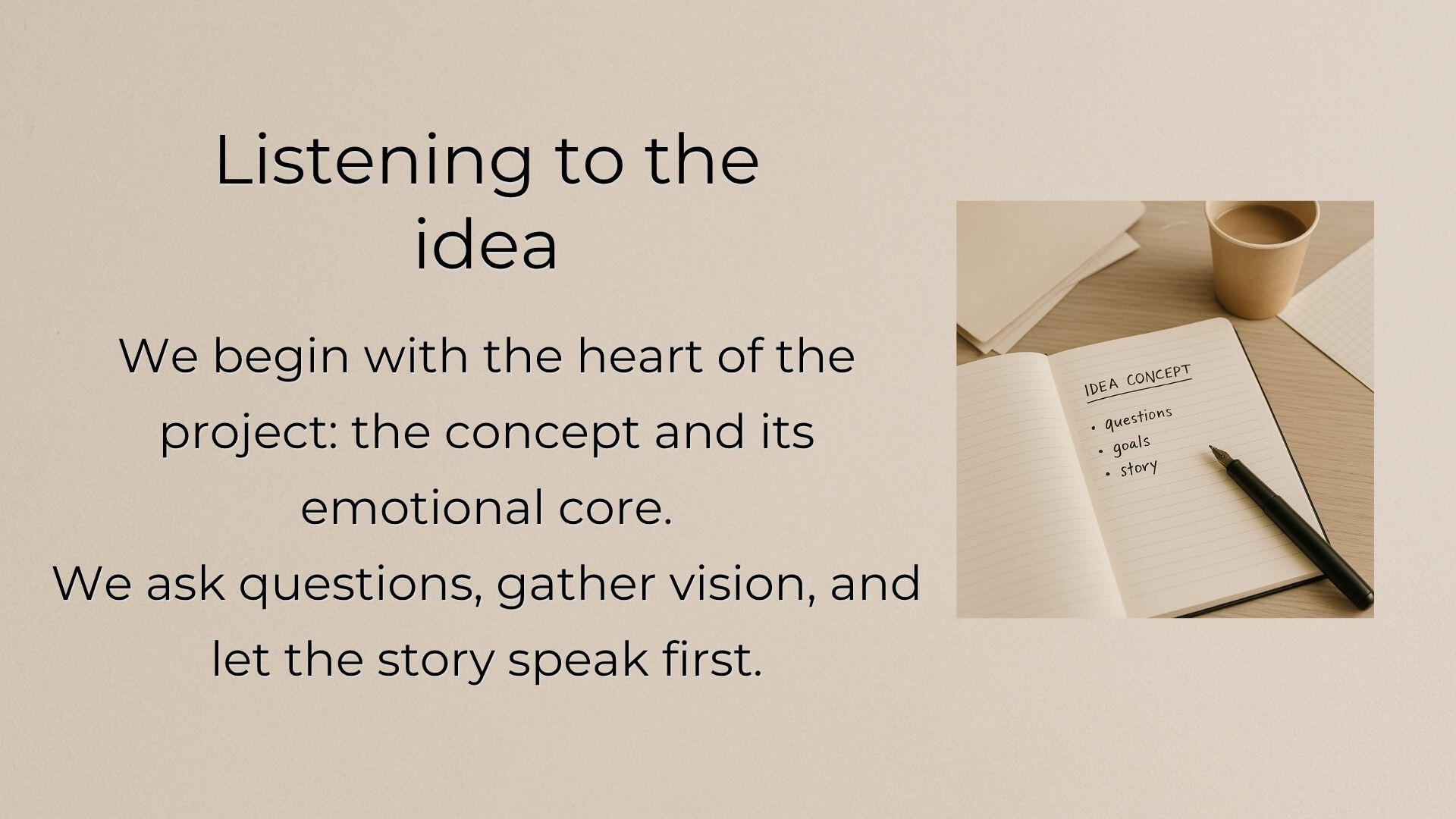
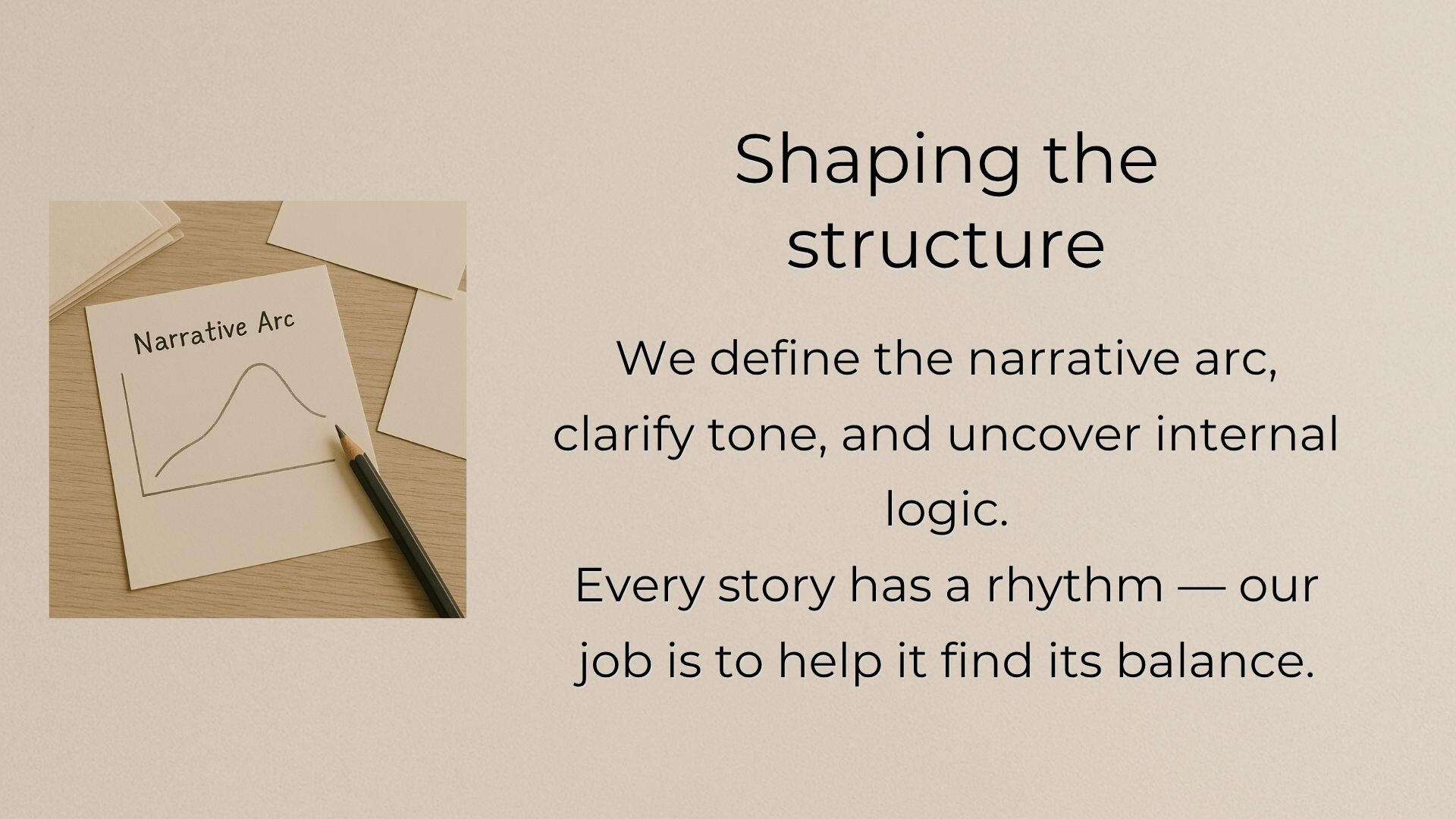
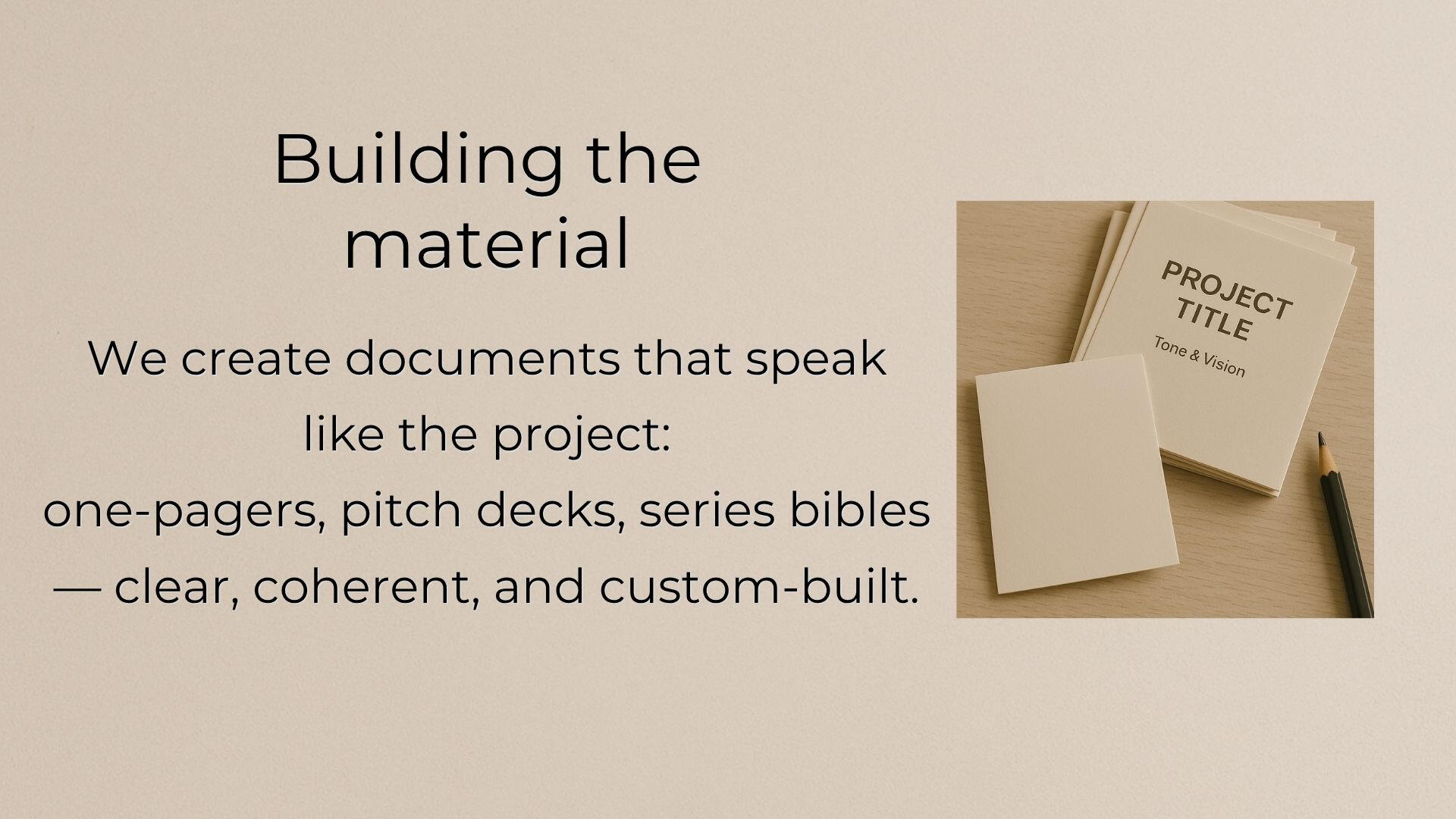
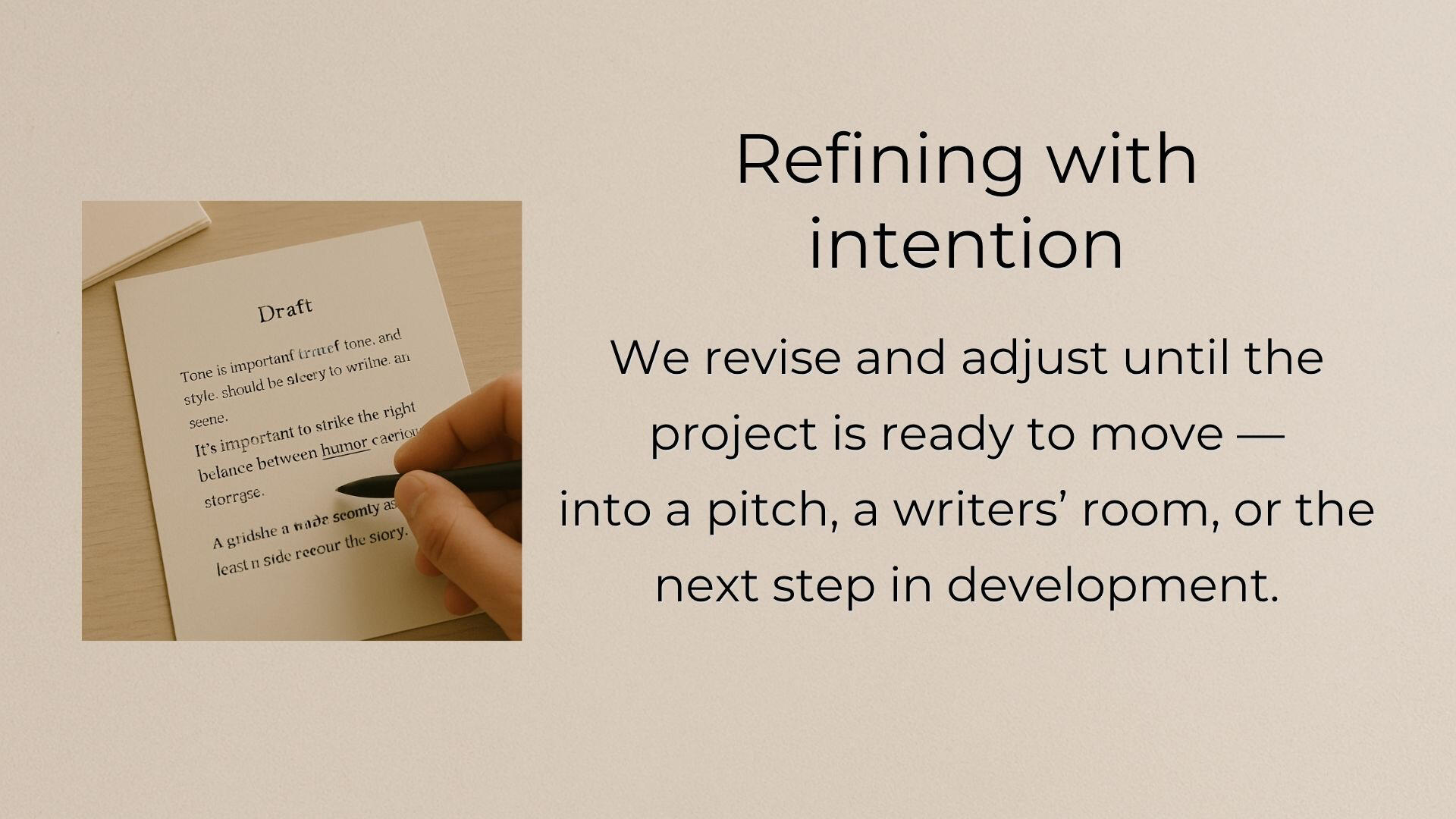
If you have a project, an idea, or even just a direction — write to us.
[email protected]

Editorial Notes
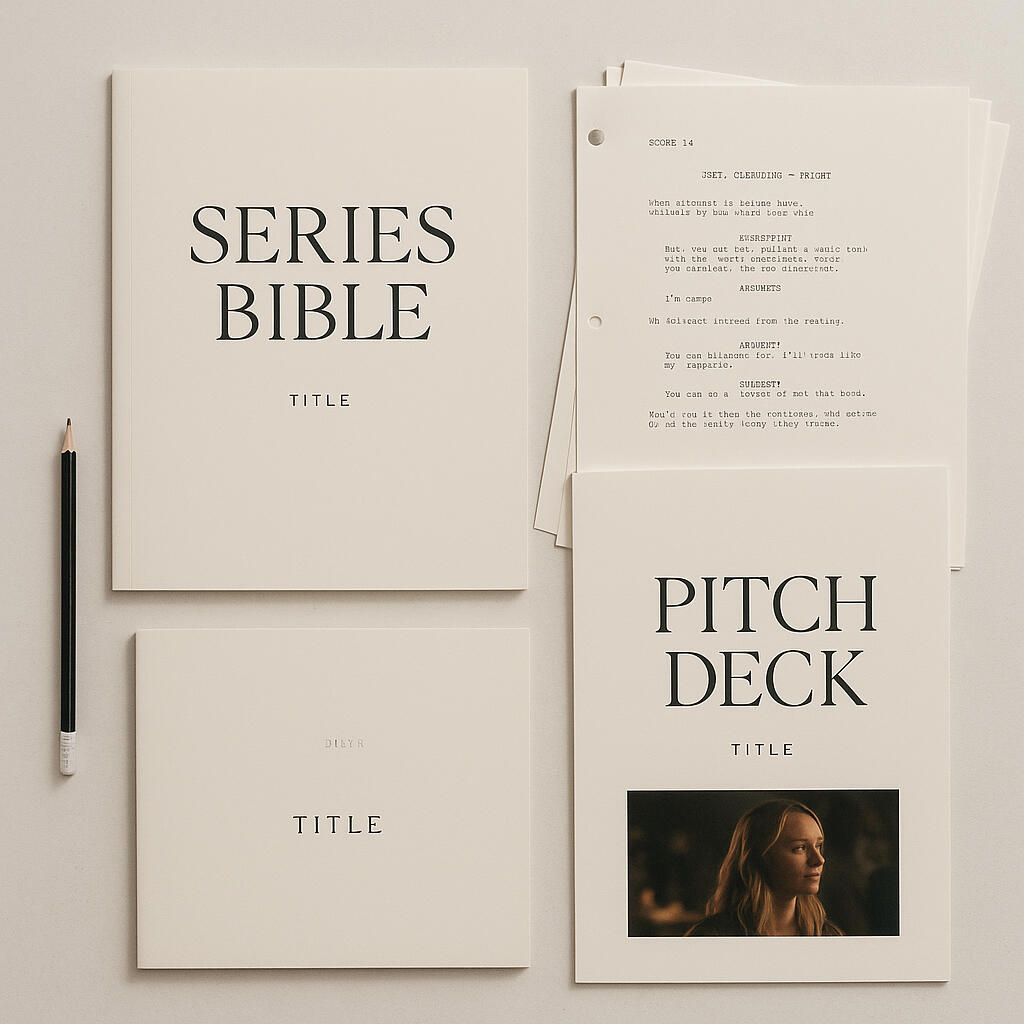
Before a story is written, it needs to be shaped.
Here we share thoughts, insights and notes on narrative development for screen projects.This isn’t a blog. It’s an editorial line.We talk about pitch decks, one-pagers, story bibles — and the invisible structure behind every presentation that speaks clearly.
Professional pitch decks: storytelling begins on page one
A pitch deck is not just a visual presentation.
It’s a narrative declaration — tone, rhythm, and style should already be doing the work.Editorial materials for screen projects aren’t there just to explain.
They position, evoke, persuade.
That’s why building a professional pitch deck means writing a structure, not just laying out slides.Whether it’s for a series, a film or a documentary, every section of a pitch deck should reflect the spirit of the project: synopsis, concept, structure, vision. Everything should speak as if the story already exists.At First Frame Room, we build professional pitch decks that breathe.
That don’t chase trends — they elevate vision.
That speak the industry’s language, without silencing the author’s.
You don’t fill in a pitch deck. You write it.
Search online how to pitch a screen project, and you’ll find tools, frameworks, “ready-to-use” templates.But a pitch deck is not a form to be filled.
It’s a narrative document.Producers, platforms, funds — they read between the lines.
And between the slides.They can tell when a project has a direction, and when it’s just been placed into a structure designed for someone else.We believe presentation is part of storytelling.The format matters — but only after tone, structure, and intent.A good pitch deck doesn’t just inform.
It makes you want to know how it ends.
The Series Bible. Not sacred — but essential.
It’s called a “bible,” but it’s not a doctrine.
The series bible is the development document that carries a project from concept to pitch.It outlines story structure, tone, character arcs, and the direction of the narrative — horizontal and vertical.Some bibles are short and strategic. Others become visual dossiers.
But one thing’s clear: it’s not a summary.A strong bible doesn’t explain the show. It organizes it.A character sheet isn’t just backstory — it’s a map.
A section on themes isn’t just intention — it’s the way the story breathes.Every page should help producers and readers understand the project — before it’s made.At First Frame Room, we build series bibles that don’t mimic a format.
They reframe its purpose: to guide, support, and speak — before the show does.
Pitching a screen project: structure, tone and timing
Pitching a project doesn’t mean telling everything.
It means knowing what matters, and what doesn’t need to be said.Producers, agents, and platforms aren’t just looking for the story.
They’re looking for a reason it should exist — now.Overlong synopses. Concepts that explain every beat. Visually packed presentations with no structure…
These are signs someone is trying to convince with noise.The right pitch materials don’t shout.
They position.Sometimes a clear one-pager is enough. Sometimes a deeper series bible is what’s needed.
It depends on the story, the moment, and the recipient.At First Frame Room, we help authors and producers create presentations that don’t beg for attention — they invite it.Pitching is a narrative act. And every project deserves an elegant entry.
One-pager: summary or strategy?
Everyone asks for a one-pager. Few really know what it should say.It’s not a synopsis. It’s not a summary. It’s not just “one page.”A one-pager is the short form of a long vision.In a single page, it should carry:
• the story’s voice
• its positioning
• its potential arcA good one-pager doesn’t list. It suggests.It gets people to read more.
It opens doors — without asking.Some overfill it.
Others empty it in the name of brevity.At First Frame Room, we build it like the entrance to a narrative world.
With rhythm, intent, and visual identity.A project can start anywhere.
But a one-pager must always be memorable.
The 3 invisible mistakes in a narrative presentation
Some mistakes are obvious: messy synopsis, disconnected concept, unreadable fonts.Others are subtle — but they leave a mark.They’re the reason a pitch is read… and then forgotten.Here are the three most common:1. Too confident in form, not enough in voiceThe idea seems clear, but the text feels generic.
The tone is neutral. The language is safe.
The reader understands everything… and remembers nothing.2. Everything, all at onceA pitch is not a manual.
It’s meant to spark curiosity — not explain every detail.When you say too much, you leave no space for imagination.3. No idea who’s readingMaterials meant for “everyone” often speak to no one.Producers know when a pitch was built with a reader in mind — and when it wasn’t.At First Frame Room, this is where we begin:
with voice, strategy, and the reader.Because pitching isn’t just a creative act.
It’s an intentional act of listening.
Visual tone: the part that’s written without words
There’s the written content. And then, there’s how it presents itself.
Visual tone isn’t just design. It’s rhythm, breath, identity.A pitch deck, a one-pager, a bible — they aren’t just “text to format.”
They’re materials that need to speak before they’re read.The consistency between voice and layout.
The use of white space.
The way a title introduces a section.It all shapes the reading experience.
Even when no one notices.A strong visual tone isn’t loud. It’s intentional.
It helps the reader step into the project at the right pace.At First Frame Room, we work on content and form together.
Because a visually neutral presentation often becomes narrative silence.
Who reads a pitch — and what they really expect
A pitch isn’t a message in a bottle.
It’s a document that needs to reach someone — someone with little time, many stories to assess, and a sharp radar for intent.That reader might be a producer, a story editor, an agent, or someone in development.But whoever it is, they’re not reading out of curiosity.They’re scanning to see:
• if there’s narrative identity
• if the project has positioning
• if it’s worth moving forwardA pitch isn’t just about what happens in the story.
It needs to show why this story makes sense now, in this context.At First Frame Room, we build presentations with that perspective.
Not just for the story — but for the person receiving it.Because a good pitch isn’t just well written.
It’s written in the right direction.
The voice of the project is not the voice of the author
One of the hardest things to accept — especially for writers — is that a project has a voice that isn’t their own.
Not opposing.
Just different.The author’s voice is personal, internal, fluid.
But the project’s voice is external, structured, readable.
It’s the one that speaks when the author is silent.
The one that introduces the idea when no one is there to explain it.Sometimes, a pitch sounds like it was written by someone too close to the story.
Too detailed, too emotional, too “me.”
Other times, it’s the opposite: dry, generic, disconnected.The voice of the project sits in between.
It tells you what the story wants to be —
without needing to tell you who wrote it.At First Frame Room, that’s what we work on:
helping stories find a voice that can speak for the author —
not over them.
A voice that is clear, credible, and ready to be heard.
Even films need to speak before they exist
A film can begin with a scene.
An image.
A specific feeling that, at first, doesn’t even have words.
But sooner or later, it will need to find them.Cinema is meant to be seen.
But before that, it must be read.Editorial treatments, pitch decks, lookbooks — these are tools to tell a film before it’s made.
Not to replace the vision, but to prepare its ground.Sometimes a project lives entirely in the author’s mind.
But if it doesn’t reach a producer, a fund, a decision-maker… it stays there.
Perfect — but still.At First Frame Room, we work with those who have vision.
Our job is to give it shape, voice, and structure — before it becomes image.Because even the most visual film needs, first, to be believed.
And to be believed, it has to know how to speak.
Logline: stop trying to impress, start trying to say something
A logline is not a clever phrase.
It’s not a slogan.
And it’s not there to make you sound smart, deep, visionary or already halfway to an award ceremony.A logline works when it tells us what happens, to whom, and why we should care.
You don’t have to explain everything. You just have to make us want more.We read them every day.
And too often, we find lines like:“In a world where time bends to emotion, a man discovers that nothing is what it seems.”
Lovely. But what happens? Who is he? Why should we care?A good logline isn’t poetic. It’s clear.
The poetry can come later. When the story is ready to carry it.Here are three questions that help:
• Who is your protagonist?
• What do they desperately want, and what’s standing in their way?
• What makes their situation unique?A young Vatican archivist discovers a manuscript that seems to predict the pope’s death—but every attempt to share it makes it more real.It’s not award-worthy. But it does the most important thing: it makes you want to turn the page.And if your project is strong (it is), the logline’s job is simply to open the door.
Not build the room. Not decorate it.
Just open it with honesty.At First Frame Room, we craft loglines by listening to the story before the style.
We know it works when it doesn’t try to be smart—just true.
We write to intrigue the reader, but more than that, to remind the writer: this is still all waiting to be told.
Pitch Sample
This demo is an example of a narrative pitch presentation designed for original audiovisual concepts, in the style and format typically used for international submissions.
It includes selected elements showcasing tone, structure, and world-building potential.Please note: For confidentiality reasons, all visible text has been partially blurred or altered.
The complete version is available upon request in a professional contextOptional closing line if you want to sound just a bit mysterious:Because some stories deserve to be seen… just not all at once.

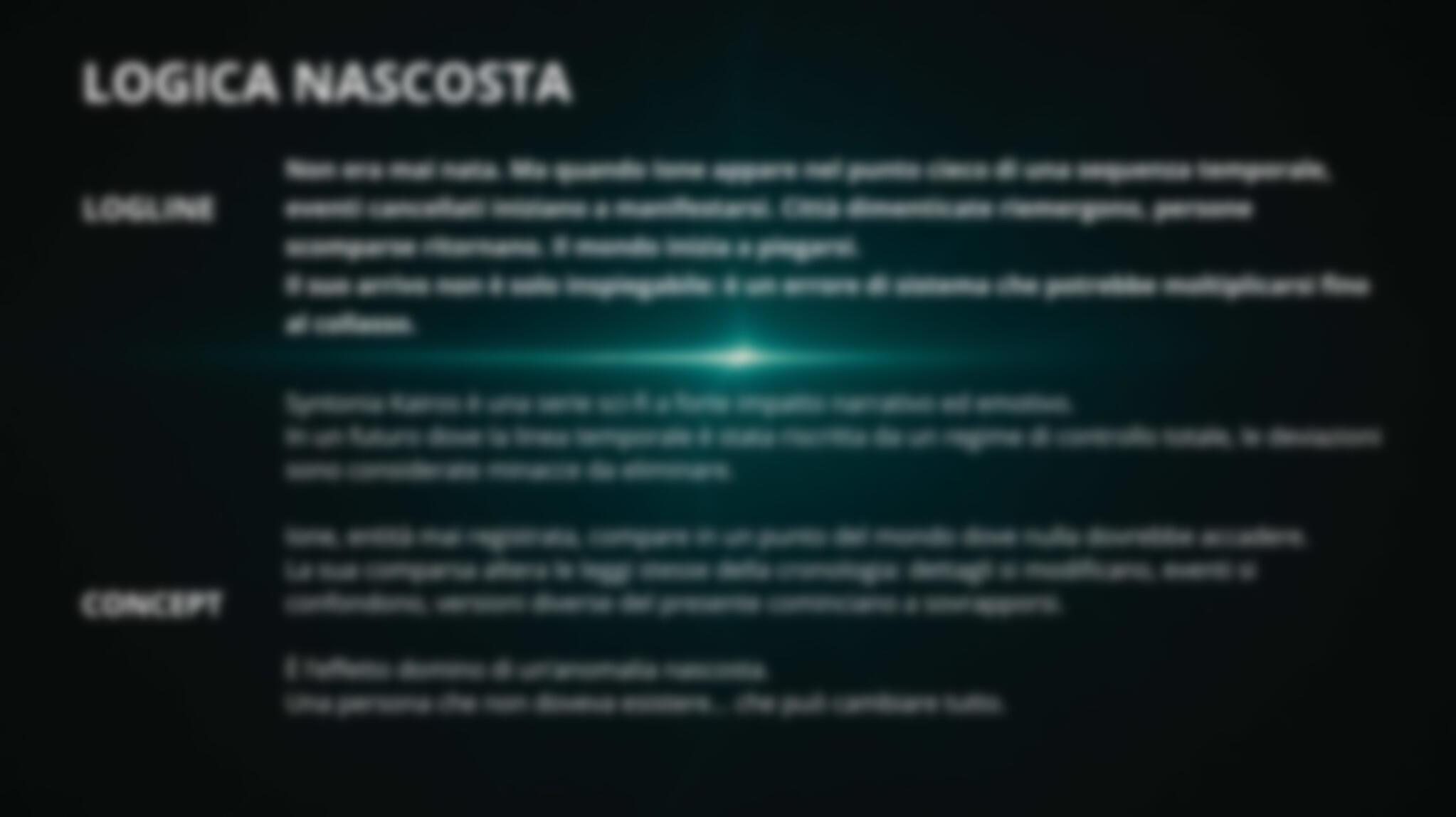
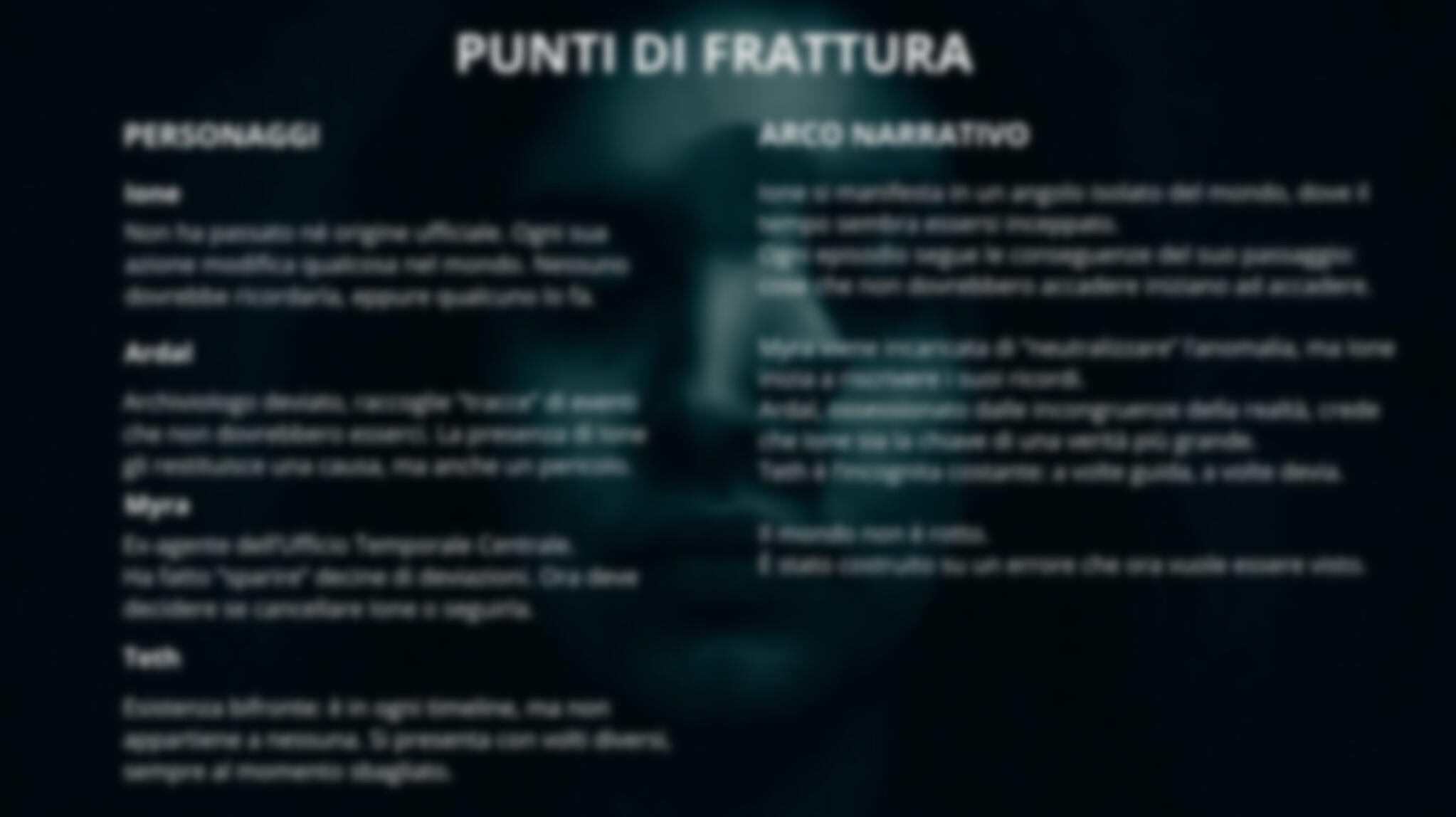
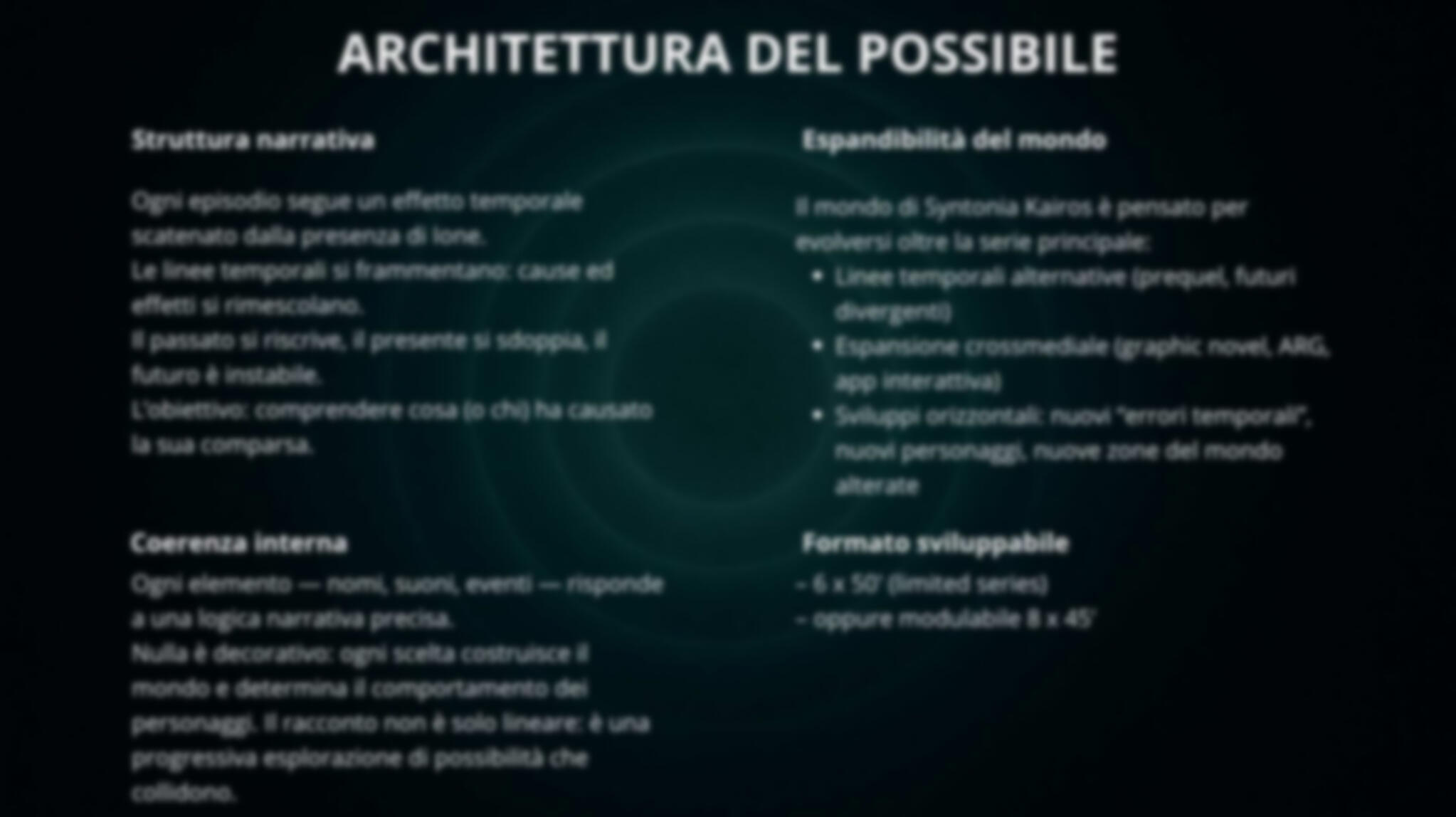

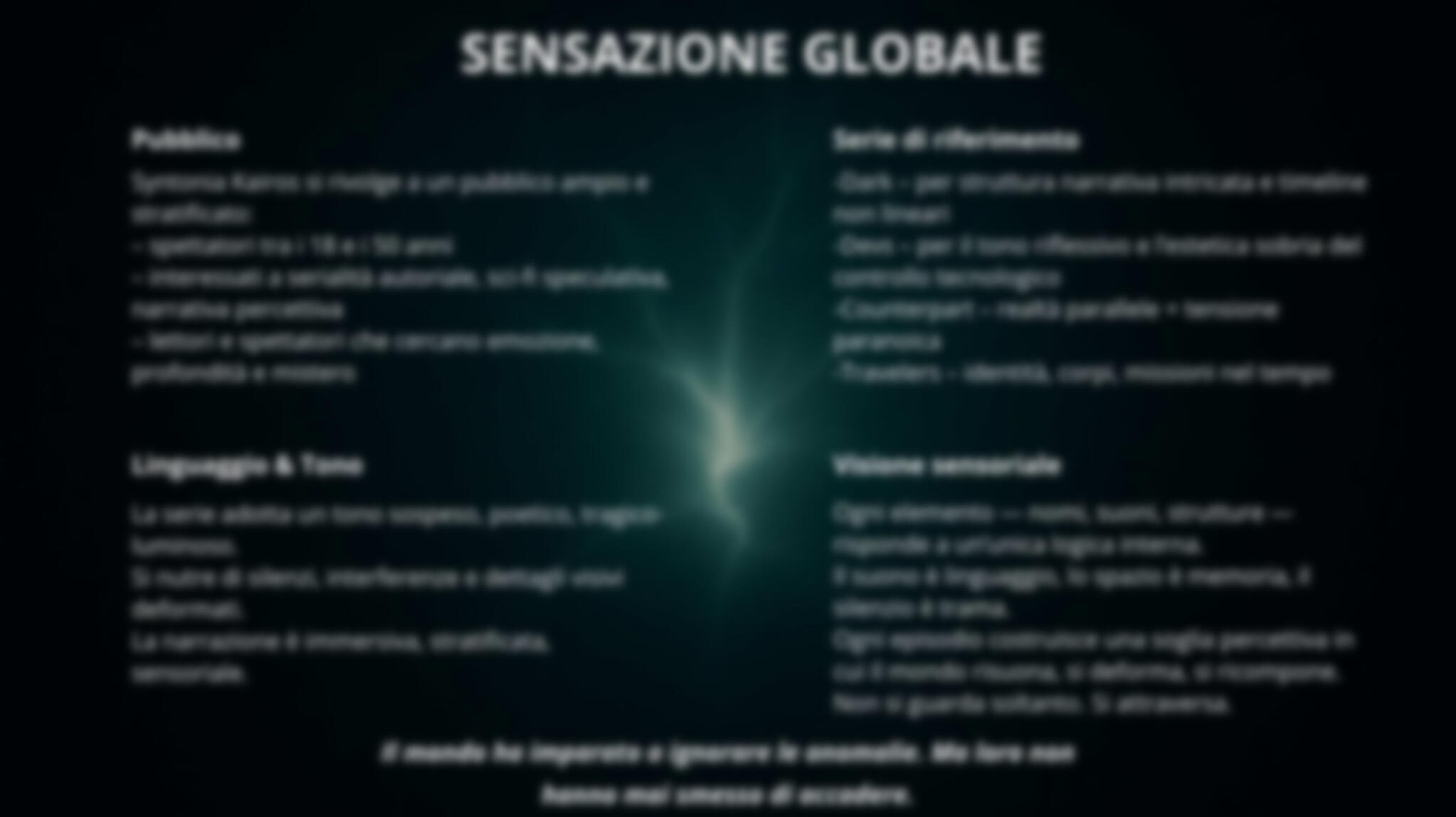
Contact
Your story deserves a First Frame.
Tell us what you’re working on — or what’s still just an idea.
We’re here to listen, shape, and begin.
Based in Italy and the UK
Rome · Milan · Bologna · London
